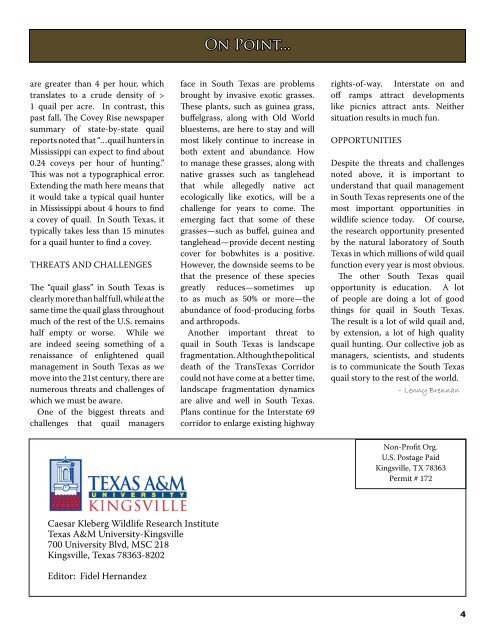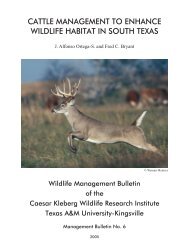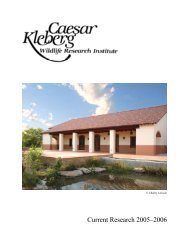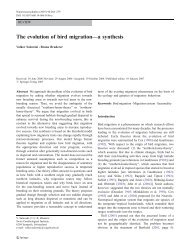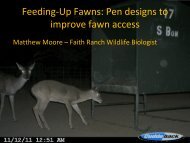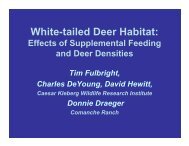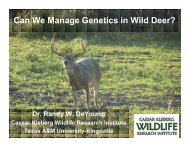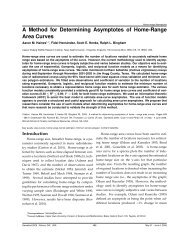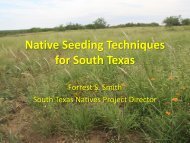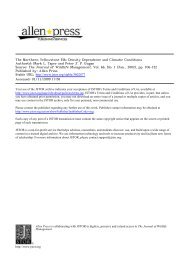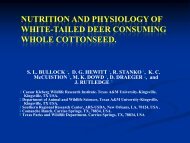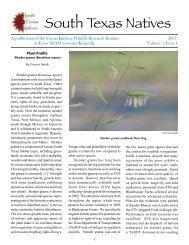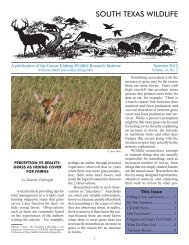The Bobwhite Post - Caesar Kleberg Wildlife Research Institute ...
The Bobwhite Post - Caesar Kleberg Wildlife Research Institute ...
The Bobwhite Post - Caesar Kleberg Wildlife Research Institute ...
Create successful ePaper yourself
Turn your PDF publications into a flip-book with our unique Google optimized e-Paper software.
...Memoirs of On a <strong>Wildlife</strong> Point... Biologistare greater than 4 per hour, whichtranslates to a crude density of >1 quail per acre. In contrast, thispast fall, <strong>The</strong> Covey Rise newspapersummary of state-by-state quailreports noted that “…quail hunters inMississippi can expect to find about0.24 coveys per hour of hunting.”This was not a typographical error.Extending the math here means thatit would take a typical quail hunterin Mississippi about 4 hours to finda covey of quail. In South Texas, ittypically takes less than 15 minutesfor a quail hunter to find a covey.THREATS AND CHALLENGES<strong>The</strong> “quail glass” in South Texas isclearly more than half full, while at thesame time the quail glass throughoutmuch of the rest of the U.S. remainshalf empty or worse. While weare indeed seeing something of arenaissance of enlightened quailmanagement in South Texas as wemove into the 21st century, there arenumerous threats and challenges ofwhich we must be aware.One of the biggest threats andchallenges that quail managersface in South Texas are problemsbrought by invasive exotic grasses.<strong>The</strong>se plants, such as guinea grass,buffelgrass, along with Old Worldbluestems, are here to stay and willmost likely continue to increase inboth extent and abundance. Howto manage these grasses, along withnative grasses such as tangleheadthat while allegedly native actecologically like exotics, will be achallenge for years to come. <strong>The</strong>emerging fact that some of thesegrasses—such as buffel, guinea andtanglehead—provide decent nestingcover for bobwhites is a positive.However, the downside seems to bethat the presence of these speciesgreatly reduces—sometimes upto as much as 50% or more—theabundance of food-producing forbsand arthropods.Another important threat toquail in South Texas is landscapefragmentation. Although the politicaldeath of the TransTexas Corridorcould not have come at a better time,landscape fragmentation dynamicsare alive and well in South Texas.Plans continue for the Interstate 69corridor to enlarge existing highwayrights-of-way. Interstate on andoff ramps attract developmentslike picnics attract ants. Neithersituation results in much fun.OPPORTUNITIESDespite the threats and challengesnoted above, it is important tounderstand that quail managementin South Texas represents one of themost important opportunities inwildlife science today. Of course,the research opportunity presentedby the natural laboratory of SouthTexas in which millions of wild quailfunction every year is most obvious.<strong>The</strong> other South Texas quailopportunity is education. A lotof people are doing a lot of goodthings for quail in South Texas.<strong>The</strong> result is a lot of wild quail and,by extension, a lot of high qualityquail hunting. Our collective job asmanagers, scientists, and studentsis to communicate the South Texasquail story to the rest of the world.– Lenny BrennanNon-Profit Org.U.S. <strong>Post</strong>age PaidKingsville, TX 78363Permit # 172<strong>Caesar</strong> <strong>Kleberg</strong> <strong>Wildlife</strong> <strong>Research</strong> <strong>Institute</strong>Texas A&M University-Kingsville700 University Blvd, MSC 218Kingsville, Texas 78363-8202Editor: Fidel Hernandez


